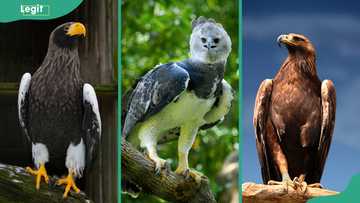What is the biggest owl in the world? Top 10 largest breeds to ever exist
Owls are intriguing birds that have been part of human mythology for a long time. Many people have various perceptions when it comes to these birds, as they view them as good-luck charms, while others believe they are demonic harbingers of death. Did you know that owls can swivel their heads up to 270 degrees in either direction? Discover some of the world’s biggest owls and interesting facts about them.

Source: Getty Images
TABLE OF CONTENTS
We strive to provide our readers valuable insights and information through our various rankings and lists. We used data from largest.org, facts.net, Randomfun, Gitnux and other publicly available data to analyse the owls’ sizes.
10 biggest owls in the world
Besides being nocturnal animals, owls can fly nearly silently and stay hidden thanks to exceptional camouflage. Owls are found in every continent except Antarctica.
The Eurasian eagle owl (Bubo bubo) and the Blakiston's fish owl (Bubo blakistoni) are among the largest owl species. Here are some of the biggest owl species and what makes each unique.
| Species | Weight (kg/lbs) | Length (cm/in) |
| Eurasian eagle-owl | 2.3 – 4.5 kg (5 – 10 lbs) | Up to 75 cm (30 inches) |
| Blakiston's fish owl | 4 – 4.5 kg (8.8 – 9.9 lbs) | Up to 95 cm (37 inches) |
| Great grey owl | 1.3 – 1.8 kg (2.9 – 4 lbs) | Up to 80 cm (31 inches) |
| Great horned owl | 1.6 – 3.5 kg (3.5 – 7.7 lbs) | Up to 64 cm (25 inches) |
| Snowy owl | 1.6 – 3.5 kg (3.5 – 7.7 lbs) | Up to 71 cm (28 inches) |
| Pharaoh eagle-owl | 1.6 – 3.2 kg (3.5 – 7 lbs) | Up to 60 cm (24 inches) |
| Indian eagle-owl | 2.7 – 3.2 kg (6 – 7 lbs) | Up to 74 cm (29 inches) |
| Cape eagle-owl | 2 – 4 kg (4.4 – 8.8 lbs) | Up to 60 cm (24 inches) |
| Verreaux's eagle-owl | 2 – 4 kg (4.4 – 8.8 lbs) | Up to 61 cm (24 inches) |
| Magellanic horned owl | 1.5–2.5 kg (3.3– 5.5 lbs) | Up to 55 cm (21.7 inches) |
1. Eurasian eagle-owl
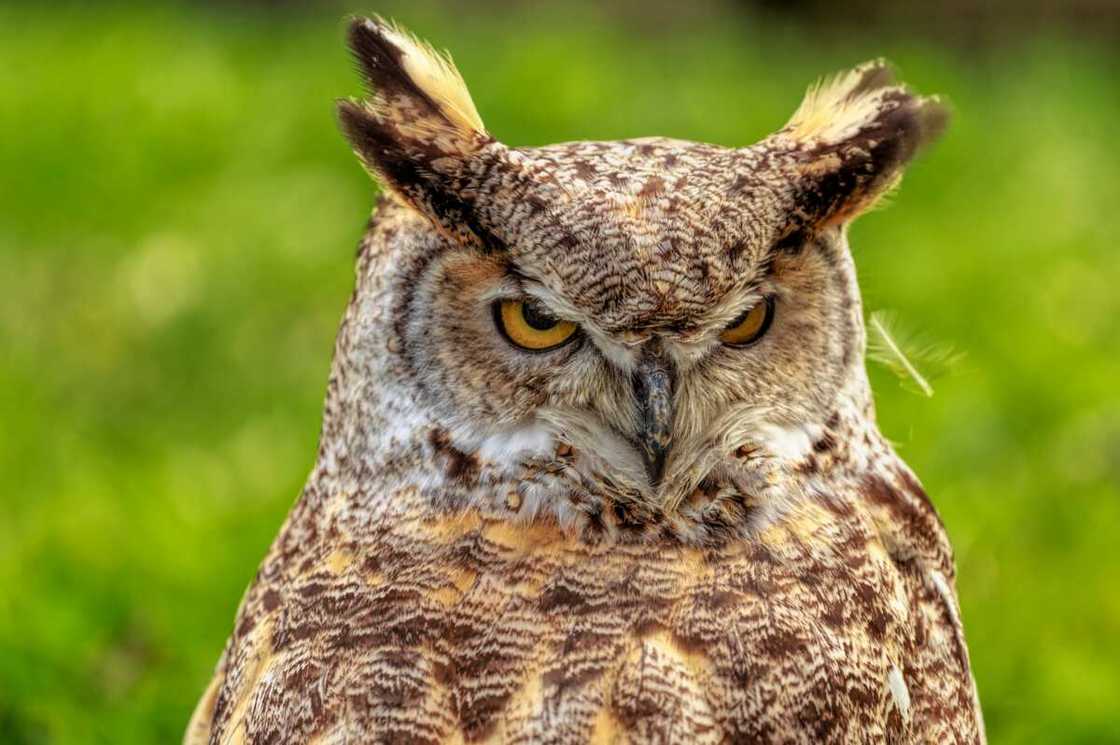
Source: Getty Images
- Scientific name: Bubo bubo
- Weight: 2.3 – 4.5 kg (5 – 10 lbs)
- Wingspan: 1.5 – 2.0m (5 – 6.6 ft)
- Length: Up to 75 cm (30 inches)
- Location: Europe, much of Asia, North Africa
The Eurasian eagle owl is one of the world's largest owls, with a wingspan of 1.8 to 2.8 m (6–9.2 ft). These majestic birds have prominent ear tufts, bright orange eyes, and a greyish-brown facial disc with a black beak.
They are native to Europe, Asia, and North Africa and can be found in woodlands, deserts, mountains, open grasslands, and riverbeds. They mainly feed on small mammals such as voles, rats, and rabbits.
2. Blakiston's fish owl
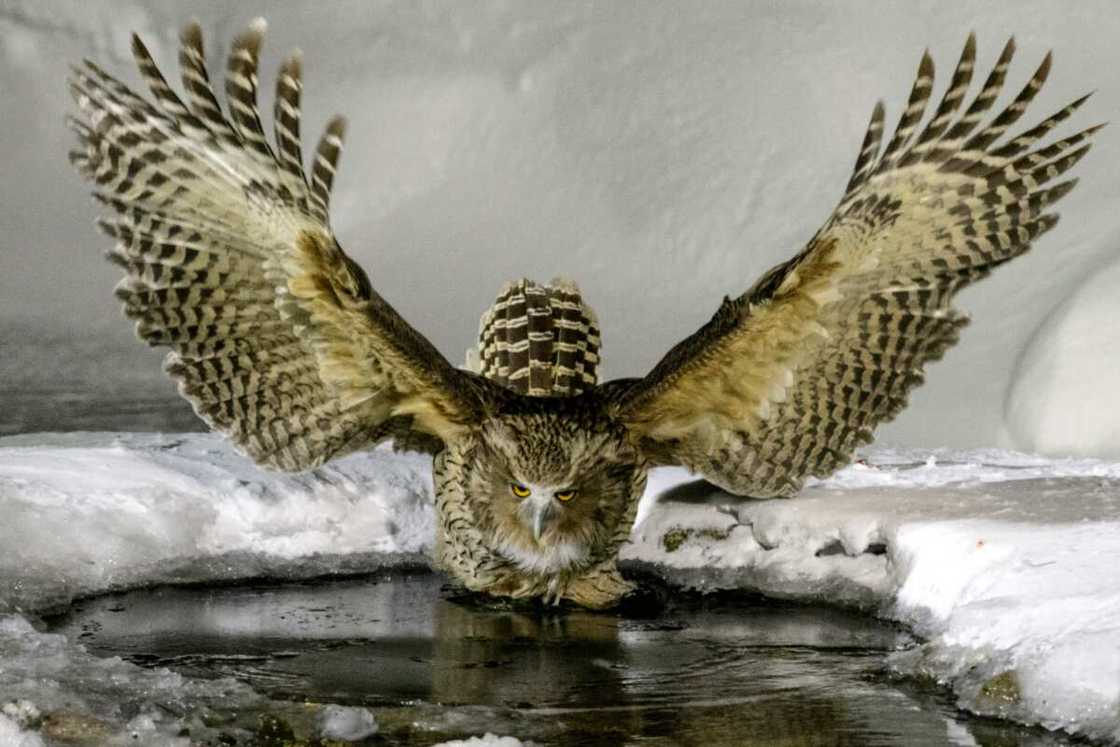
Source: Getty Images
- Scientific name: Bubo blakistoni
- Weight: 4 – 4.5 kg (8.8 – 9.9 lbs)
- Wingspan: 1.7–2 m (5–7 ft)
- Length: Up to 95 cm (37 inches)
- Location: Eastern Russia, northern China, and Korea
This majestic bird is the largest owl in the world. Blakiston fish owl size in weight spans between 4 to 4.5 kg (8.8–9.9 lbs), making it the heaviest owl species. What about Blakiston’s fish owl’s wingspan? This gigantic bird is also the biggest owl by wingspan, ranging between 1.7 m and 2 m (5–7 ft).
The Blakiston's fish owl is one of the biggest owls in the world compared to humans. They are mainly found in Eastern Russia, northern China, and Korea.
3. Great grey owl

Source: Getty Images
- Scientific name: Strix nebulosa
- Weight: 1.3 – 1.8 kg (2.9 – 4 lbs)
- Wingspan: 1.5 – 1.8 m (5 – 6 ft)
- Length: Up to 80 cm (31 inches)
- Location: Boreal forests of North America, Europe, and Asia
The Great Grey Owl, scientifically known as Strix nebulosa, is the largest owl species in the northern hemisphere, with a wingspan ranging between 1.5 – 1.8 m (5 – 6 ft). Additionally, it is one of the tallest species of owl in the world, with a length of up to 80 cm (31 in). Its name is derived from the mottled grey colouration of the body.
4. Great horned owl
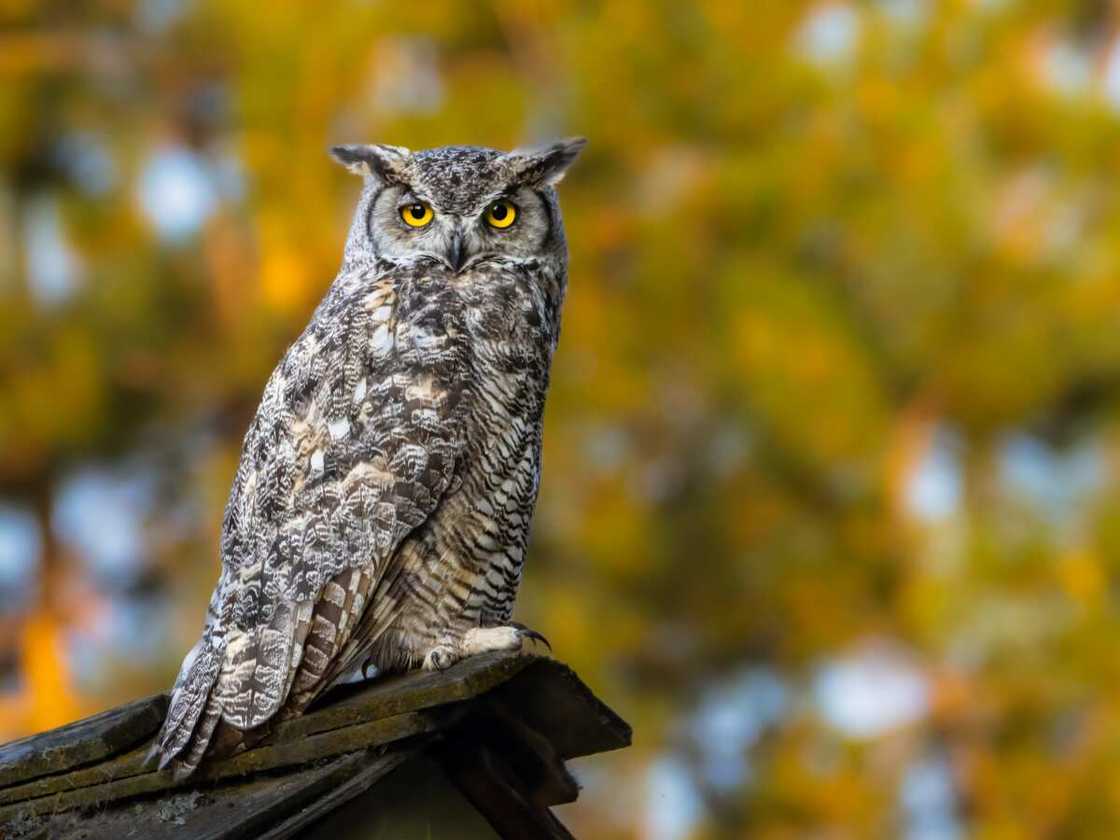
Source: Getty Images
- Scientific name: Bubo virginianus
- Weight: 1.6 – 3.5 kg (3.5 – 7.7 lbs)
- Wingspan: 1.5 – 1.8 m (5 – 6 ft)
- Length: Up to 64 cm (25 inches)
- Location: Most of North and South America
This powerful predator can take down birds and mammals even larger than itself, but it also dines on daintier fare, such as tiny scorpions, mice, and frogs. Its weight ranges between 1.6 – 3.5 kg (3.5 – 7.7 lbs). These majestic birds are primarily found in North and South America. They have ultra-soft feathers to help mute any additional flapping sounds.
Snowy owl
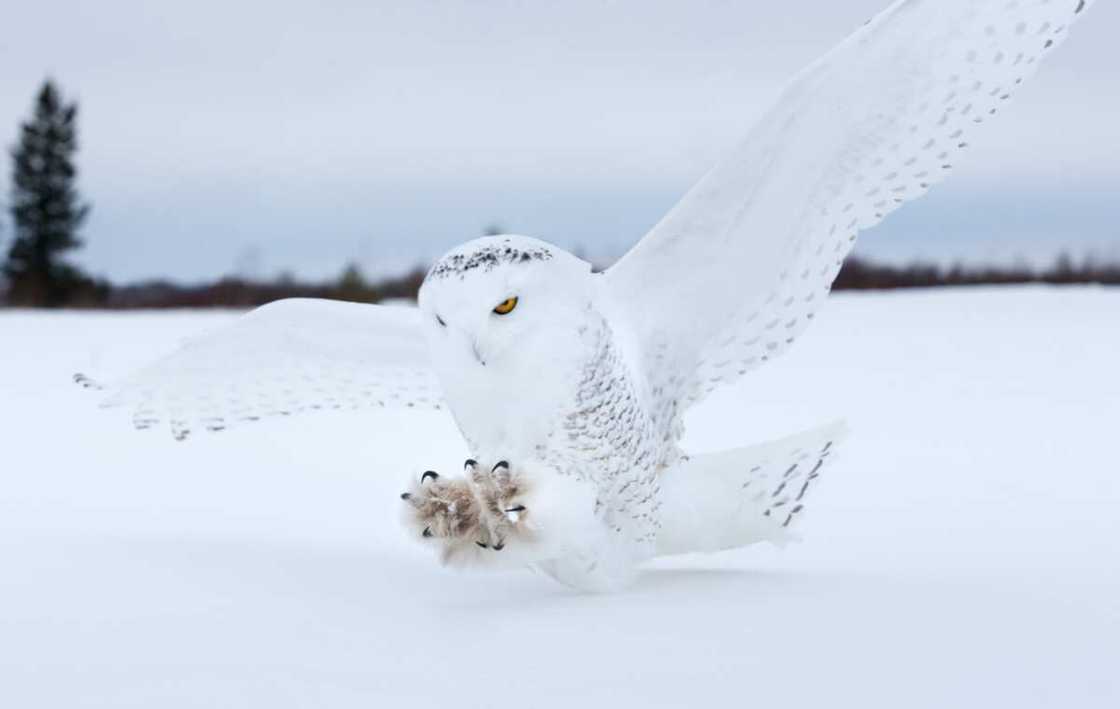
Source: Getty Images
- Scientific name: Bubo scandiacus
- Weight: 1.6 – 3.5 kg (3.5 – 7.7 lbs)
- Wingspan: 1.5 – 1.8 m (5 – 6 ft)
- Length: Up to 71 cm (28 inches)
- Location: Arctic tundra and mountains
Snowy Owls live in open, treeless areas of the Arctic called tundra, such as prairies, fields, marshes, beaches, and dunes. These predators are opportunistic hunters who eat small mammals, such as lemmings, ground squirrels, voles, hares, and rabbits. Their weight ranges between 1.6 and 3.5 kg (3.5–7.7 lbs), and body length can reach up to 71 centimetres (28 in).
6. Pharaoh eagle-owl
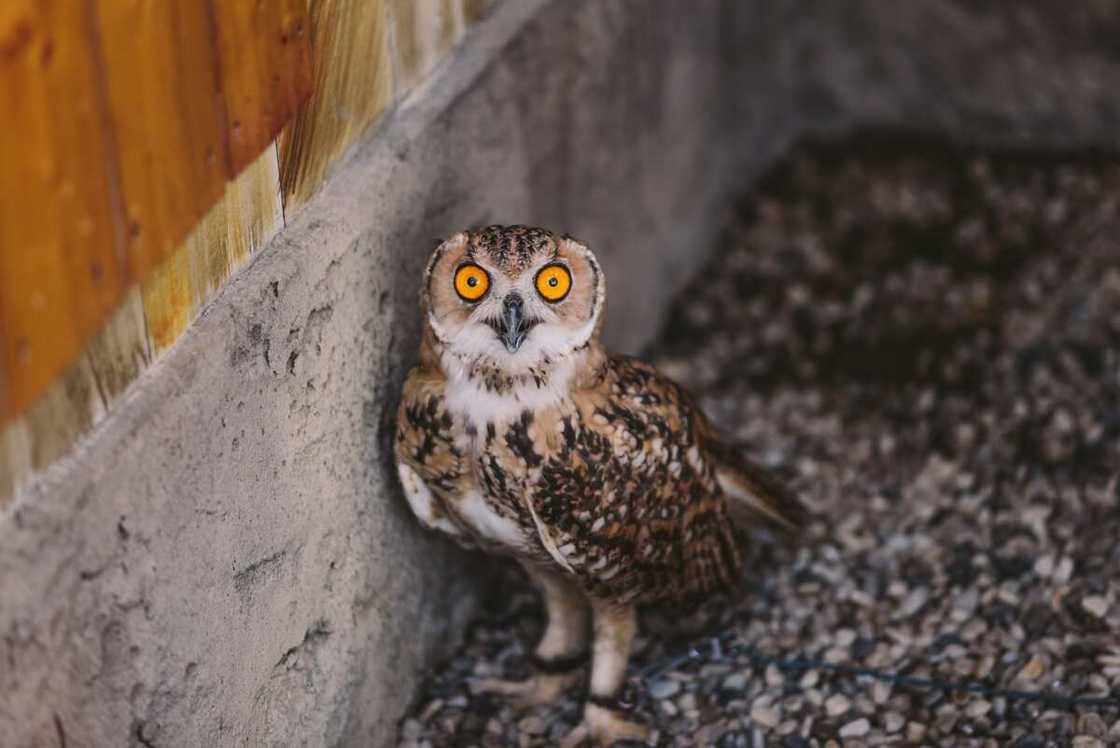
Source: Getty Images
- Scientific name: Bubo ascalaphus
- Weight: 1.6 – 3.2 kg (3.5 – 7 lbs)
- Wingspan: 1.6 – 1.8 m (5.2 – 6 ft)
- Length: Up to 60 cm (24 inches)
- Location: Sub-Saharan Africa
The Pharaoh eagle-owl is a fairly large owl with relatively short and pointed ear tufts. These birds have cat-like faces, orangey-yellow eyes, short ear tufts, and a dark rim on their faces.
They can grow up to 60 centimetres (24 in) with a wingspan between 1.6 and 1.8 m (5.2–6 ft). These birds are found across Sub-Saharan Africa and the Arabian Peninsula. They stand out because they are monogamous and form a lifelong breeding pair.
7. Indian eagle-owl

Source: UGC
- Scientific name: Bubo bubo indica
- Weight: 2.7–3.2 kg (6 – 7 lbs)
- Wingspan: 1.8 – 2.5 m (6 – 8.2 ft)
- Length: Up to 74 cm (29 inches)
- Location: Indian subcontinent and parts of Southeast Asia
The Indian eagle-owl, scientifically known as Bubo bubo indica, is an owl species native to hilly and rocky scrub forests in the Indian Subcontinent. They have a relatively similar appearance to the Eurasian eagle owl but are smaller and have weaker streaking on their underparts.
These birds weigh approximately 2.7 kg and 3.2 kg (6–7 lbs) and can have a length of up to 74 cm (29 in). Indian Eagle Owl can live up to 20 years.
8. Cape eagle-owl
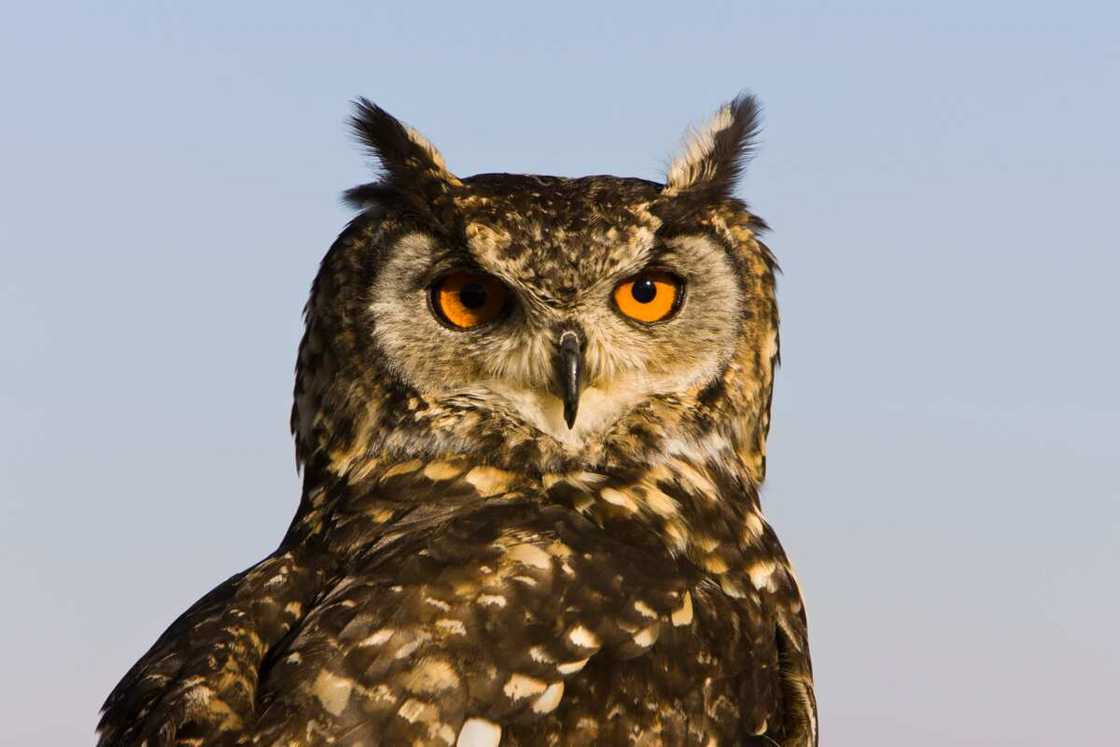
Source: Getty Images
- Scientific name: Bubo capensis
- Weight: 2 – 4 kg (4.4 – 8.8 lbs)
- Wingspan: 1.5 – 2 m (5 – 6.6 ft)
- Length: Up to 60 cm (24 inches)
- Location: Sub-Saharan Africa
The Cape eagle-owl is the third biggest owl ever found in South Africa. This bird species’ habitat is mainly in the rugged and rocky terrain, mainly in the mountains.
The sides of the upper breast are densely blotched black, while the rest of the underparts have some blackish spots and coarse bars. These birds feed on mammals, from small rodents and shrews up to the size of hares.
9. Verreaux's eagle-owl
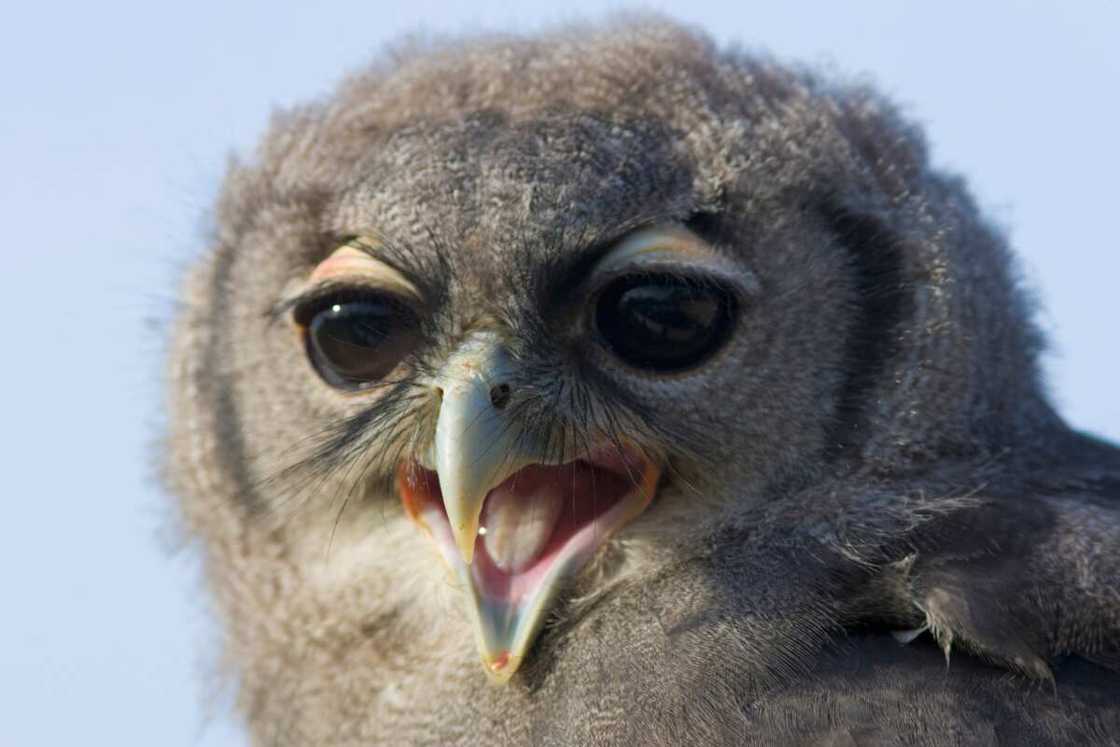
Source: Getty Images
- Scientific name: Bubo lacteus
- Weight: 2 – 4 kg (4.4 – 8.8 lbs)
- Wingspan: 1.8 – 2.1 m (6 – 7 ft)
- Length: Up to 61 cm (24 inches)
- Location: Sub-Saharan Africa
The Verreaux's eagle-owl (Giant Eagle-owl or the Milky Eagle-owl) species is named after Jules Verreaux, a botanist and ornithologist from France. They are primarily found in Sub-Saharan Africa and prefer dry savanna dotted with trees and thorny shrubs habitat.
These raptors mainly feed on medium-sized mammals, such as rats, hares, mongooses, monkeys, hedgehogs, and hyraxes.
10. Magellanic Horned Owl

Source: Getty Images
- Scientific name: Bubo magellanicus
- Weight: 1.5–2.5 kg (3.3– 5.5 lbs)
- Wingspan: 1.1–1.3 meters (3.6–4.3 ft)
- Length: Up to 55 cm (21.7 inches)
- Location: South America
The Magellanic horned owl, or lesser horned owl, is known for its rounded body, white neck and throat, brown and white patches on the back, and two feathers behind the eyes that look like ears. They weigh approximately 1.5kg and 2.5 kg (3.3– 5.5 lbs), and their wingspan ranges between 1.1 and 1.3 meters (3.6–4.3 ft). These birds of prey are mainly found in South America.
What is the world's largest owl?
The Blakiston's fish owl is the world's largest owl, with their bodies weighing around 4 to 4.5 kg (8.8–9.9 lbs). They have an average wingspan of 1.7m and 2 m (5–7 ft).
What is the most powerful owl?
The Great horned owl is one of North America's largest and most powerful birds of prey. The fierce predator can weigh up to 4 pounds, and its talons require 28 pounds of force to open.
How big are giant owls?
The Verreaux's eagle-owl, also known as the Giant Eagle-owl, weighs 2 – 4 kg (4.4 – 8.8 lbs) and has a wingspan ranging between 1.8 and 2.1 m (6 – 7 ft).
With over 200 species living on various continents, these are the biggest owls in the world. These birds of prey are apex predators that help control populations of small mammals and insects. Their presence is essential for maintaining the functionality of ecosystems worldwide.
Legit.ng recently published an exciting post about the top 10 largest eagles in the world. Eagles are remarkably agile and can reach impressive speeds when diving or chasing prey. These birds have eyesight that is around five times better than a human’s.
Eagles have heavy heads, beaks, and large wingspans for grasping and killing prey. They are used as national symbols for various countries. Read on to discover some of the largest eagles that cut across the sky in one of the most majestic ways.
Source: Legit.ng


